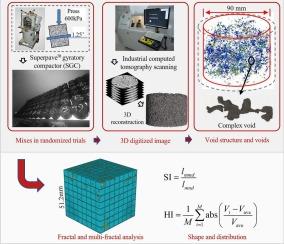离散颗粒组合中空隙结构的非均质性检测:基于案例的沥青混合料数字图像处理分析
IF 4.6
2区 工程技术
Q2 ENGINEERING, CHEMICAL
引用次数: 0
摘要
离散颗粒组件(dpa),如热混合沥青(HMA),表现出显著的性能变化,通常是由内部空隙结构的非均质性驱动的。本研究旨在建立一个实用的框架来量化和分析HMA空隙的结构非均质性。为此,采用高分辨率三维数字图像处理,从随机沥青混合料数据库中提取并重建空洞结构。随后,利用统计、分形和多重分形描述符对孔隙形态、空间分布和体积分类进行量化。孔隙比、均匀性指数和形状指数等参数用于表征全局和局部异质性,而多重分形谱指标则可以更深入地了解几何复杂性。最后,分析了粒子干涉与结构非均质性的关系。结果表明,孔洞结构具有明显的非均质性。具体来说,统计描述符的变异系数可以达到30%左右,异常值的比例可以高达7%。对于基于分形几何的描述符,这些值甚至更大。此外,粒子干涉通过改变孔隙形状大大增加了孔隙的非均质性。因此,控制颗粒骨架特征可作为调控孔隙结构非均质性的有效途径,为提高颗粒材料的工程可靠性提供理论支持。本文章由计算机程序翻译,如有差异,请以英文原文为准。

Heterogeneity detection of void structure in discrete particle assemblies: Case-based analysis on asphalt mixtures utilizing digital image processing
Discrete Particle Assemblies (DPAs), such as Hot Mix Asphalt (HMA), display notable performance variability, often driven by internal void structure heterogeneity. This study aims to develop a practical and applicable framework for quantifying and analyzing structural heterogeneity in HMA voids. To this end, high-resolution 3D digital image processing was employed to extract and reconstruct void structures from a randomized asphalt mixture database. Subsequently, void morphology, spatial distribution, and volumetric classification are quantified using statistical, fractal, and multifractal descriptors. Parameters such as void ratio, Homogeneity Index, and Shape Index are used to characterize global and local heterogeneity, while multifractal spectrum metrics provide deeper insight into geometric complexity. Finally, the correlation between particle interference and structural heterogeneity was analyzed. The results confirm that the void structure exhibits significant heterogeneity. Specifically, the coefficient of variation for Statistical Descriptors can reach about 30 %, and the proportion of outliers can be as high as 7 %. For Fractal Geometry-Based Descriptors, these values are even larger. Furthermore, particle interference was found to greatly increase void heterogeneity by altering void shape. Therefore, controlling particle skeleton features can serve as an effective way to regulate void structure heterogeneity, providing theoretical support for improving the engineering reliability of granular materials.
求助全文
通过发布文献求助,成功后即可免费获取论文全文。
去求助
来源期刊

Powder Technology
工程技术-工程:化工
CiteScore
9.90
自引率
15.40%
发文量
1047
审稿时长
46 days
期刊介绍:
Powder Technology is an International Journal on the Science and Technology of Wet and Dry Particulate Systems. Powder Technology publishes papers on all aspects of the formation of particles and their characterisation and on the study of systems containing particulate solids. No limitation is imposed on the size of the particles, which may range from nanometre scale, as in pigments or aerosols, to that of mined or quarried materials. The following list of topics is not intended to be comprehensive, but rather to indicate typical subjects which fall within the scope of the journal's interests:
Formation and synthesis of particles by precipitation and other methods.
Modification of particles by agglomeration, coating, comminution and attrition.
Characterisation of the size, shape, surface area, pore structure and strength of particles and agglomerates (including the origins and effects of inter particle forces).
Packing, failure, flow and permeability of assemblies of particles.
Particle-particle interactions and suspension rheology.
Handling and processing operations such as slurry flow, fluidization, pneumatic conveying.
Interactions between particles and their environment, including delivery of particulate products to the body.
Applications of particle technology in production of pharmaceuticals, chemicals, foods, pigments, structural, and functional materials and in environmental and energy related matters.
For materials-oriented contributions we are looking for articles revealing the effect of particle/powder characteristics (size, morphology and composition, in that order) on material performance or functionality and, ideally, comparison to any industrial standard.
 求助内容:
求助内容: 应助结果提醒方式:
应助结果提醒方式:


